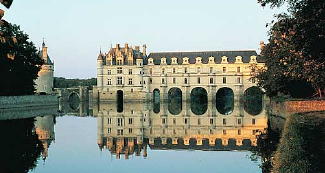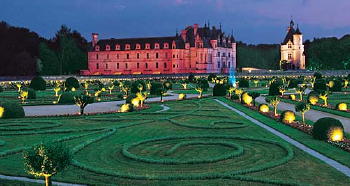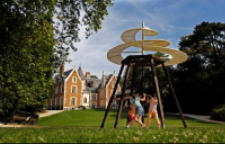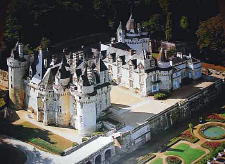
France’s Loire Valley is renowned for its magnificent chateaus. Scores are scattered over the landscape and choosing which to see is a challenge. On this leg of our journey, John and I rented a car and made our home base in the quiet village of Chenonceaux, staying in a hotel just 300 meters from the chateau. Chenonceau Chateau is one of the most visited sites in France for good reason. Elegantly built on stone arches that span the Cher River, it is set on a grand estate of gardens and forest. Inside, every room reflects the taste of the beautiful and/or brilliant women who reigned here during the 16th-18th centuries; it is often called “the ladies’ chateau.”
The first lady was Katherine Briconnet, who oversaw the building of the chateau before royalty took over and Diane de Poitiers moved in. Diane, the mistress of King Henry II, held court, designed an elaborate formal garden, and took charge of interior design. When Henry died, his widow, Catherine de Medici, booted Diane out (to Chaumont, another chateau you can visit), and ordered her own garden. She imported orange trees and, “endowed with diabolical Florentine tendencies,” as the brochure puts it, she turned the estate into a profitable enterprise. Not always scheming, she was also renowned for throwing great parties.

A guided tour helps, but it is impossible to keep track of French royalty — fortunately, it’s not required for enjoying this fabulous place. Tip: Arrive at 9 a.m. when the chateau opens and you’ll avoid the crowds. In the Louis IV living room, notice the portrait of Madame Dupin. She owned Chenonceau in the 18th century and was known for her grace and generosity; because of her, the chateau wasn’t destroyed in the Revolution.
On the grounds are several gardens, a pretty restaurant, a maze of 2000 yew trees, and a picnic area. Unlike most chateaus, there is some handicapped access.
 The chateau at nearby Amboise has a different atmosphere. It is set fortress-like on a hill above the lively town. The royal apartments, with 16th-century furnishings, lie behind towers and battlements. A helpful brochure explains architectural periods and royal history without being bogged down with names and dates. A small chapel on the site holds the tomb of Leonardo DaVinci, who spent his last years in Amboise.
The chateau at nearby Amboise has a different atmosphere. It is set fortress-like on a hill above the lively town. The royal apartments, with 16th-century furnishings, lie behind towers and battlements. A helpful brochure explains architectural periods and royal history without being bogged down with names and dates. A small chapel on the site holds the tomb of Leonardo DaVinci, who spent his last years in Amboise.
 Leonardo’s home, Clos de Lucé, is not far from the chateau. Here you can see daVinci’s bedroom, study and kitchen, plus forty models of machines he designed, and then walk through a park that displays some of his works. The works of the genius are indeed a wonder, but the entry fee of 12.50 euros, about 18 dollars at this writing, seems too steep for what you get. (Just my opinion; I talked to an engineer from Canada who loved it.)
Leonardo’s home, Clos de Lucé, is not far from the chateau. Here you can see daVinci’s bedroom, study and kitchen, plus forty models of machines he designed, and then walk through a park that displays some of his works. The works of the genius are indeed a wonder, but the entry fee of 12.50 euros, about 18 dollars at this writing, seems too steep for what you get. (Just my opinion; I talked to an engineer from Canada who loved it.)
Amboise has trinket shops, restaurants and quaint buildings, but it isn’t just a tourist town, it has a life of its own. Visitors and local folk alike filled the Anne de Bretagne restaurant when we stopped in for an excellent lunch.
 A chateau we didn’t tour but had to see was Ussé, the inspiration for Charles Perrault’s “Sleeping Beauty.” It looks exactly like your fantasy of a fairy tale castle, all romantic towers and turrets. Inside, the figures of the prince and princess await, but we are told there isn’t much more.
A chateau we didn’t tour but had to see was Ussé, the inspiration for Charles Perrault’s “Sleeping Beauty.” It looks exactly like your fantasy of a fairy tale castle, all romantic towers and turrets. Inside, the figures of the prince and princess await, but we are told there isn’t much more.
We couldn’t visit the Loire Valley without a wine tasting so tracked down the Marc Brédif Cellars in Roche Carbon. A guide led us through two kilometers of caves carved into the tufa cliffs and filled with a million bottles of aging wines. Then, in the tasting room, we sipped some delectable wines.
When tourist fatigue took over, we happily returned to one of the sweetest hotels you will find for under 130 euros per night — La Roseraie. The ivy-covered hotel has 18 rooms overlooking a flowery courtyard and rose gardens and has a pool. The owners, Laurent and Sophie Fiorito, go out of their way to make every guest feel welcome. And their restaurant is superb.
For More Information:
Loire Valley Tourism
Western Loire Tourism
Tourist Office of Chinon
Next: Gardens, Castles and Caves


Comments